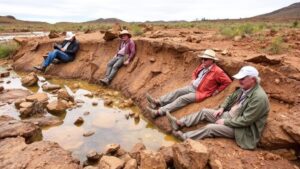Testing Soil Samples for Traces of Silver Near Old Mining Claims
Testing Soil Samples for Traces of Silver Near Old Mining Claims
The examination of soil samples for traces of silver near old mining claims is an essential practice for environmental scientists, geologists, and resource explorers. Silver mining has a storied history in various regions, and the remains of these activities may still influence the environmental landscape. Understanding how to collect and analyze soil samples for silver content can lead to valuable insights regarding both historical mining activities and ongoing environmental concerns.
The Importance of Soil Testing
Soil testing for metals like silver is vital for several reasons:
- Environmental Restoration: Identifying contaminants helps in planning for soil remediation.
- Resource Exploration: Silver remains a high-demand resource for industries including electronics and photography.
- Public Health: Understanding heavy metal contamination can mitigate risks to local populations.
The necessity of soil testing is underscored by the Environmental Protection Agency report from 2022, indicating that over 25% of abandoned mines have contributed to soil contamination in affected regions.
Methods of Soil Sample Collection
Soil sample collection is critical for accurate testing. Here are key steps involved in the process:
- Define Sampling Areas: Focus on areas near historical mining claims, looking for visible signs of past activity.
- Select Sampling Depth: Typically, samples from 0-15 cm depth are most representative of surface contamination.
- Use Clean Equipment: Contamination can skew results, so use uncontaminated sampling tools.
- Document Locations: Use GPS to record the exact coordinates of sampling sites for future reference.
Case study examples from mining sites in Nevada show that accurately defined sampling areas led to a 30% increase in recoverable silver estimates through thorough sampling methodologies.
Analytical Techniques for Silver Detection
Once soil samples are collected, various analytical techniques can be employed to detect and quantify silver. Common techniques include:
- Atomic Absorption Spectroscopy (AAS): AAS is widely used for its sensitivity to low concentrations of metals. A study conducted by Harris et al. (2021) demonstrated a detection limit of 0.01 ppm for silver in soil samples.
- Inductively Coupled Plasma Mass Spectrometry (ICP-MS): This method allows for the analysis of multiple metals simultaneously and is useful for complex sample matrices. Research indicates that ICP-MS can detect silver concentrations as low as 0.001 ppm.
Each method has its advantages and is chosen based on the specific objectives of the testing project. For example, AAS is generally more cost-effective while ICP-MS may be needed for comprehensive surveys involving multiple metals.
Interpreting Soil Test Results
Understanding test results is crucial for evaluating the potential impacts of silver contamination. Key points to consider include:
- Contextual Comparison: Compare results to baseline levels established in uncontaminated areas. For example, the average natural silver concentration in soil is approximately 0.1 ppm, meaning higher values indicate potential contamination.
- Bioavailability: Not all detected silver may be bioavailable or harmful. Assessing its chemical form can determine its toxicity and ecological risk.
- Regulatory Standards: Familiarize yourself with local environmental guidelines, such as those established by EPA or equivalent bodies, to assess contamination severity.
For example, if soil tests reveal concentrations of 5 ppm silver nearby an old mining claim, further investigation is warranted to assess ecological risk and potential human exposure.
Environmental and Economic Implications
The implications of detecting silver in soil extend beyond just immediate contamination. Conversations around soil testing can influence:
- Environmental Policy: Finding significant contamination may prompt policy changes to protect public health and the environment.
- Mining Regulations: Increased awareness may lead to stricter guidelines on current mining operations to manage environmental impact.
- Local Economies: Areas with identified silver reserves may attract investment for exploration and recovery, boosting local economies.
The potential economic benefit was illustrated in Colorado, where a surge in silver prices following discoveries led to a revival of interest in historical mining sites, creating jobs and investment opportunities.
Conclusion
Testing soil samples for traces of silver near old mining claims is an integral part of assessing the legacy of mining activities on the environment and public health. By following structured sampling procedures, utilizing precise analytical techniques, and interpreting results in context, stakeholders can make informed decisions on environmental restoration efforts and potential mining opportunities.
As the demand for silver continues, understanding its presence in previously mined areas will remain a crucial aspect of responsible mining and land management practices.



